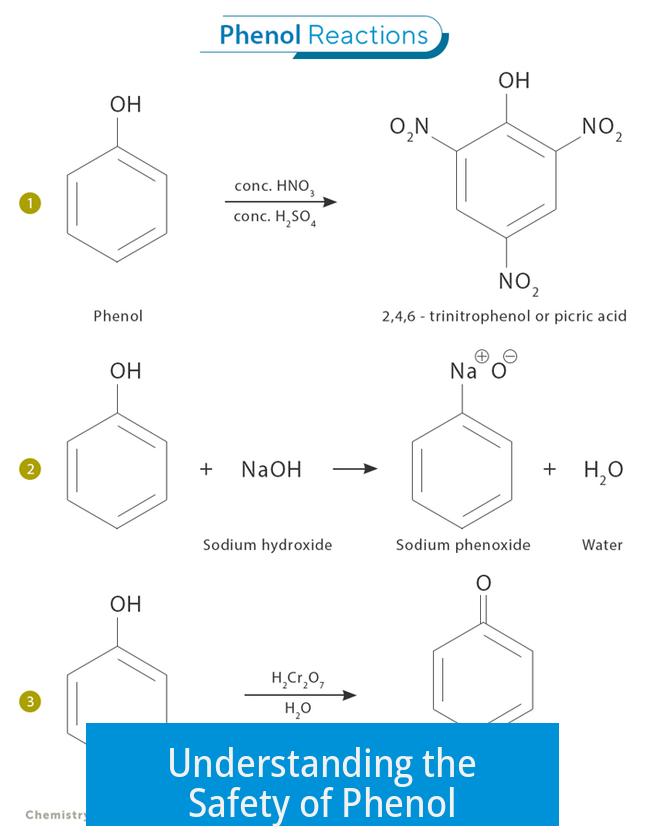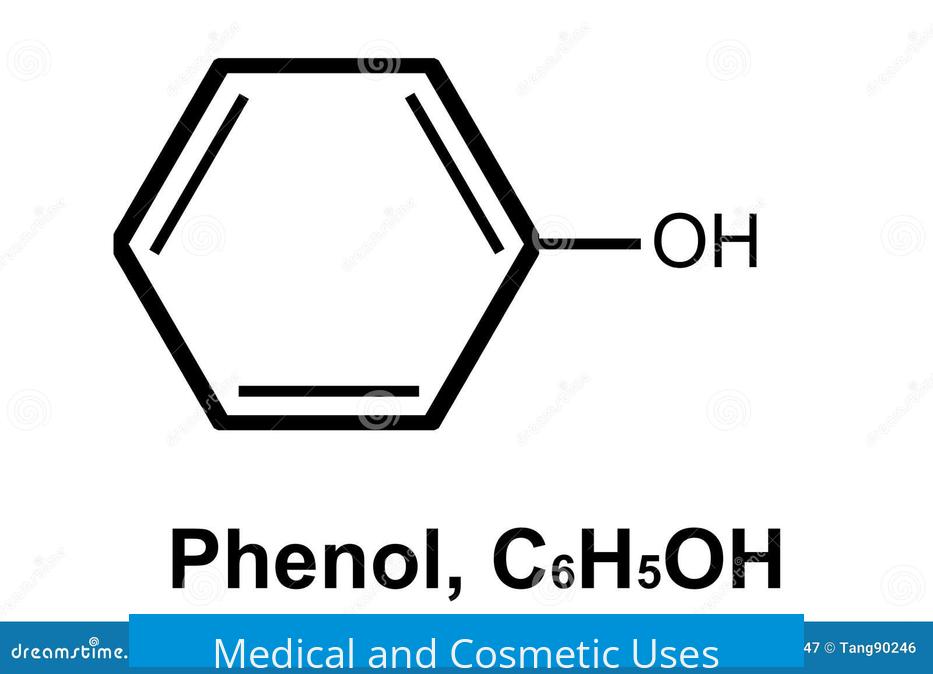Understanding the Safety of Phenol

Phenol is a chemical with known toxicity and corrosive properties, but its safety largely depends on concentration and exposure dose. At high levels, phenol is hazardous, potentially fatal with sufficient skin contact or ingestion. Small amounts, however, are used safely in medical and cosmetic contexts under strict regulations.
Phenol Toxicity and Hazard Profile
Phenol is highly corrosive and an irritant. Direct contact with concentrated phenol causes skin burns and rapid tissue damage. For example, even a single drop of pure phenol can dissolve paint instantly. Large skin exposure can lead to systemic absorption, which is dangerous and potentially lethal. Ingestion of substantial phenol amounts also poses serious health risks.
Medical and Cosmetic Uses

Phenol has a history of medical use in small amounts, such as in minor surgeries and nail removal treatments, owing to its antiseptic qualities. In cosmetics, phenol (historically called carbolic acid) prevents bacterial and mold growth. However, products containing phenol must adhere to regulatory limits, such as those established by the FDA.
Because phenol itself is notably irritating, cosmetic formulations employ only minimal concentrations, sufficient for antimicrobial effects without causing harm. Despite this, cosmetic regulations in the United States are less stringent than drug regulations, potentially leading to variability in product safety. Consumers should be cautious about products with vague ingredient disclosures.
Chemical Clarifications
- “Phenol” refers specifically to the chemical compound C6H5OH.
- Related substances named with “phenol,” like bisphenol A, are chemically distinct and have different safety profiles.
- Phenol derivatives may exhibit similar irritant properties but are not the same as pure phenol.
Safety Recommendations
Phenol exposure should be minimized, especially in concentrated forms. Avoid direct skin contact and ingestion. When working with phenol or using phenol-containing products, follow safety and handling guidelines strictly. Consumers should choose reputable products and remain informed about ingredient details.
Key Points
- Phenol is highly toxic and corrosive at high concentrations.
- Safe in low doses for medical and cosmetic purposes under regulation.
- Skin contact with phenol can cause burns and systemic toxicity.
- Phenol derivatives differ chemically and may carry different risks.
- Caution is advised when using products containing phenol.
Can Someone Give Me Some More Info On The Safety Of Phenol?
Is phenol safe? The quick answer is: it depends on the amount and the context. Phenol, a potent chemical, has a long history and is well-studied. But handling it without care? That’s a recipe for trouble. Let’s unpack the mystery surrounding this fascinating yet tricky substance.
Phenol—sometimes called carbolic acid—is a chemical with a reputation. It’s both useful and hazardous. If you’ve ever wondered how safe phenol really is, you’re not alone. From medical uses to cosmetic creams, phenol pops up in places you might not expect.
A Chemist’s Tale: Why Dose Matters
You’ve heard the phrase “the dose makes the poison,” right? Phenol perfectly demonstrates this principle. Even water can drown you, but phenol’s danger truly depends on how much you come into contact with.
Extensive studies over the decades show that tiny amounts can be safe and even helpful. But large doses spell trouble. Phenol is highly toxic, corrosive, and, in higher concentrations, fatal.
The Medical Side: More Than Just a Chemical Scare
Surprisingly, phenol has been used to good effect in medical settings. It’s employed in small surgeries and to stop nail growth after removal. Why? Because phenol kills cells effectively and quickly. But don’t get any ideas about DIY nail removal — it’s best left to professionals.
In the medical world, phenol’s use is carefully controlled. It’s a precise tool—not something thrown around casually.
Phenol In Your Cosmetics? Yes, But With Limits
You might be wondering, “Wait, phenol is in things I put on my face?” That’s true. Small amounts are found in some cosmetics to stop bacteria and mold from ruining the product.
This makes sense—phenol is a powerful antiseptic. But don’t worry: cosmetic products are regulated. The FDA keeps an eye on things, making sure phenol levels stay low enough to avoid harm.
That said, the cosmetic regulation system has its quirks. It’s not as strict as food or drugs. Some companies might sneak by with slightly higher amounts, but it’s generally bad business to mess up your customers’ skin.
The Real Danger: Handling Phenol Directly
If you work with pure phenol, like many chemists or lab workers do, you’ve seen its power firsthand. Here’s a little story: someone spilled just one drop of phenol on a plastic hood visor. Moments later, there was a neat hole where the paint vanished. Phenol ate right through it.
That’s the stuff that makes phenol both fascinating and scary. It’s corrosive and an extremely potent irritant. Touch it directly in large amounts and expect burns. Bigger exposures can lead to phenol being absorbed through your skin, causing systemic toxicity—and it might even kill you.
Clearing Up Confusion: Phenol Isn’t All Phenols
One common mix-up involves phenol and its derivatives. Many chemicals have “phenol” in their names but act differently. For example, bisphenol A (BPA), often mentioned in plastics debates, is not the same as phenol.
Phenol itself refers to a specific compound. Derivatives share some properties but can behave differently and have different safety profiles. So if your ingredient label says “bisphenol,” don’t assume it will act exactly like pure phenol.
Should You Be Worried?
If you occasionally come into contact with items containing tiny phenol amounts—like certain cosmetics—you have little to fear. It’s all about the dose. The FDA steps in to regulate and limit concentrations, so hazardous exposures through products are unlikely.
But if you’re dealing with pure phenol or even moderately concentrated solutions, caution is crucial. Protective gear, proper ventilation, and training are a must. Remember, a drop can damage materials, let alone your skin.
Tips If You Encounter Phenol
- Don’t take phenol lightly. Treat it like the corrosive chemical it is.
- Use gloves and safety goggles. Skin exposure can cause burns and absorption.
- Follow dosage guidelines. In medicine and cosmetics, phenol only appears in minuscule doses.
- If you spill pure phenol, clean it carefully. Methanol or ethanol wipes can neutralize small spills. But avoid skin contact!
- Stay informed about the products you use. Check labels and research ingredients if you’re concerned about phenol.
Final Word: Approach Phenol With Respect
Phenol is a classic chemical that balances usefulness with danger. Its safety depends entirely on how much you handle and how you handle it. Its history in medicine and cosmetics shows how versatile it is in tiny doses, but its harsh corrosive nature demands respect.
Before jumping into phenol-containing products or workplace exposure, ask yourself: do I really know the dosage and safety measures? If not, it’s best to steer clear or seek expert advice.
So, next time you come across phenol, remember this: it’s a chemical with a dual personality. Use it wisely, and it’s a helpful friend. Ignore its power, and it’ll show you just how serious chemical safety is.
Got phenol questions or experiences? Drop a comment below. Let’s keep this safety chat going!
Is phenol safe to use in small amounts in cosmetics?
Yes. Small amounts are used to prevent bacteria and mold. The FDA regulates cosmetic products, so harmful levels are unlikely in approved items.
What happens if phenol gets on the skin?
Phenol is highly corrosive. One drop can damage surfaces and skin. Large amounts can cause burns and absorb into the body, leading to serious harm.
Can phenol poisoning occur through skin contact?
Yes. Phenol can absorb through the skin. Exposure to large amounts may be fatal due to its toxicity.
Are all chemicals with “phenol” in their name the same in safety terms?
No. Phenol is a specific chemical. Derivatives like bisphenol A are different and may have distinct properties and risks.
Why should one be cautious with phenol despite its common uses?
Phenol is a strong irritant and corrosive at higher doses. Safe when used properly, but improper exposure can cause harm.





Leave a Comment